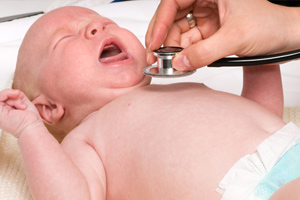INFANTS who present to hospital with respiratory symptoms should undergo routine nasopharyngeal aspiration, an Australian expert says.
Professor Dominic Fitzgerald, a senior paediatric respiratory physician at the Children’s Hospital, Westmead, in Sydney, said identifying the pathogen had multiple clinical and research benefits.
He made the comments after new US research examined the infecting pathogen in bronchiolitis.
The researchers, using sensitive polymerase chain reaction (PCR) testing, found that among 2207 children hospitalised with bronchiolitis, 26% were infected with human rhinovirus (HRV), and 72% had respiratory syncytial virus (RSV). (1)
A related editorial said the research highlighted “the extent to which we are still in the dark about bronchiolitis and how to manage it”. (2)
“The likely contribution of HRVs to acute respiratory disease cannot be minimized”, the editorial said.
Professor Fitzgerald said from a research perspective, identifying the pathogen, whether using PCR, immunofluorescence or culture, would help build understanding of bronchiolitis itself and knowledge of what pathogens were associated with subsequent episodes of viral-induced wheezing.
“I think it’s reasonable to find out what kids have got so we can see which viruses are likely to predispose them to recurrent infections”, Professor Fitzgerald said.
Clinically, identifying the infecting pathogen would assist with “cohorting” patients so that children infected with HRV alone were separated from those with RSV, to reduce the risk of cross-infection.
The US researchers found that multiple virus infections were present in 30% of hospitalised children, although these patients were not always worse off.
Children who were infected with HRV and other non-RSV viruses had a significantly shorter length of hospital stay compared with children infected with RSV alone or RSV and HRV.
Children infected with HRV alone also had a shorter hospital stay than children with RSV alone.
“Our data challenge current thinking that the infectious etiology of severe bronchiolitis does not affect short-term outcomes”, the researchers wrote.
However, the infectious aetiology did not affect rates of ventilation or admission to the ICU.
The US researchers said their study called into question the practice of cohorting inpatients based solely on their RSV status, particularly as HRV was also common and impacted clinical outcomes.
Professor Fitzgerald supported the idea of cohorting patients based on their infecting pathogen, although he acknowledged that it did slow the transfer of patients from the emergency department to the wards.
He also questioned whether the fact that HRV was detected in a quarter of the children was relevant, as other research had shown that a quarter of children in the community will have HRV yet be asymptomatic.
In Australia bronchiolitis was defined as only occurring within the first year of life, whereas this US study included children up to 2 years of age, Professor Fitzgerald said.
However, he said the study was interesting in that it highlighted the possibilities offered by sensitive molecular PCR tests.
“The technology has improved, and we’re better able to isolate evidence of viral pathogens in kids”, he said.
– Sophie McNamara
1. Arch Pediatr Adolesc Med 2012; Online 2 April
2. Arch Pediatr Adolesc Med 2012; Online 2 April
Posted 10 April 2012

 more_vert
more_vert
This paper seems to focus more on test-based outcomes than clinical ones. It is already routine in Australian to swab for RSV in children being admitted to hospital for bronchiolitis. This information is largely for epidemiological reasons, however. The admission decision depends on clinical features – specifically oxygenation and hydration – not on the infective organism. While cohorting of children with specific organisms would be ideal, holding the children in crowded EDs with other sick children while awaiting a cohorted ward bed would defeat the purpose. There is nothing sensational in this paper – we already know that support for sick babies with bronchiolitis consists almost entirely of respiratory support and fluids, with other issues being managed as they arise.